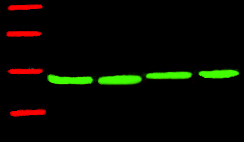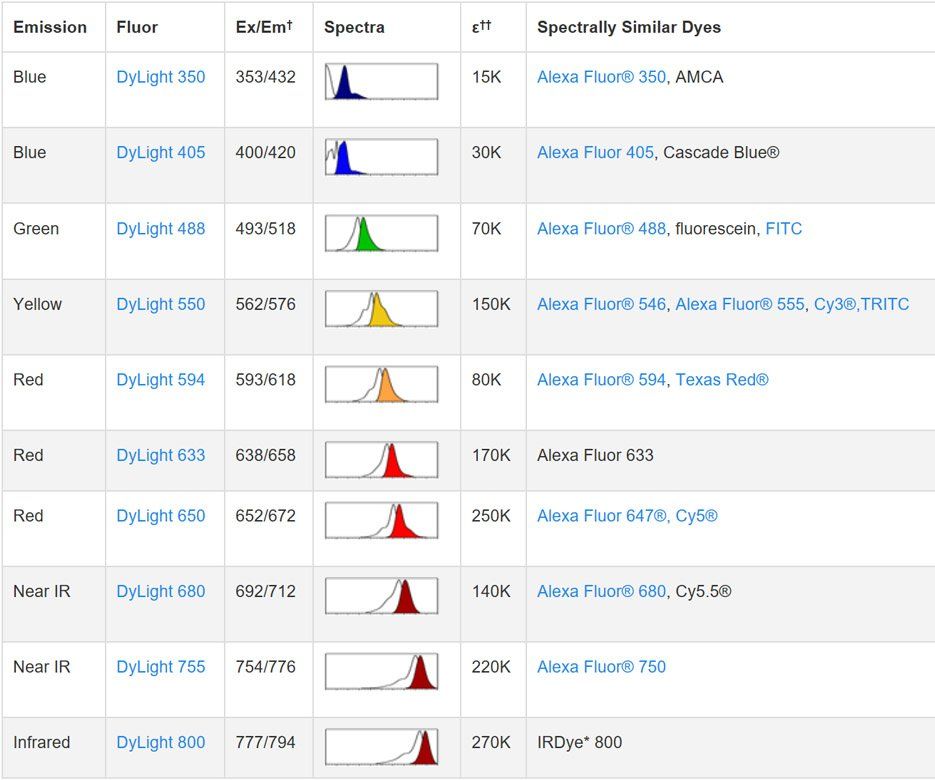| Product name | Dylight 680, Goat Anti-Mouse IgG |
| Immunogen | Mouse IgG whole molecule |
| Host | Goat |
| Reactivity | Mouse |
| Applications | FCM, ICC, IF, WB |
| Applications notes | Optimal working dilutions should be determined experimentally by the investigator. Suggested starting 1:50-1:1000 dilutions for most fluorescent applications, while 1:10000 dilutions for fluorescent assays with LI-1:COR® Odyssey equipment would be recommended. |
| Clonality | Polyclonal |
| Preparation method | Affinity purified using solid phase Mouse IgG (H&L) with finally > 95% purity based on SDS-PAGE |
| Conjugate | Dylight 680 |
| Formulation | Liquid solution |
| Features & Benefits | DyLight fluorescent dyes are a new family of dyes with improved brightness and photostability). They are better than or comparable to the best fluorescent dyes from other companies). The detection level of any fluorophore-antibody conjugate depends on brightness and photostability of the dye; antibody activity, specificity, and cross-reactivity; and the optimal moles of dye per antibody). A molar saturation curve vs fluorescence intensity, antibody activity, background level, and/or other parameters has been established for each dye to optimize the level of antibody detection and minimize background). DyLight fluorescent dyes are highly water soluble and remain fluorescent from pH 4 to pH 9). |
| Storage buffer | Liquid in PBS, pH 7.4, containing 0.02% Sodium Azide as preservative, 1% BSA as stablizer and 50% Glycerol. |
| Storage instructions | Stable for one year at -20°C from date of shipment. For maximum recovery of product, centrifuge the original vial after thawing and prior to removing the cap. Aliquot to avoid repeated freezing and thawing. |
| Shipping | Gel pack with blue ice. |
| Precautions | The product listed herein is for research use only and is not intended for use in human or clinical diagnosis. Suggested applications of our products are not recommendations to use our products in violation of any patent or as a license. We cannot be responsible for patent infringements or other violations that may occur with the use of this product. |
| Background | Abbkine secondary antibodies are available conjugated to enzyme, biotin or fluorophore for use in a variety of antibody-based applications including Western Blot, ImmunoHistoChemistry, ImmunoFluorescence, Flow Cytometry and ELISA. We offer high quality secondary antibodies from goat, rabbit and donkey sources for your each application. Serum adsorbed secondary antibodies are also available and are recommended for use with immunoglobulin-rich samples. |
| Others | The antibody reacts with whole molecule mouse IgG. It also reacts with heavy chains of mouse IgG, and light chains of all other mouse immunoglobulins. It has no reactivity on non-immunoglobulin serum proteins, while it may cross-react with immunoglobulins from other species. |

Fig.1.Western blot analysis of Arabidopsis, primary antibody (A01050) was diluted at 1:5000, secondary antibody: A23710.

Fig.2.To use the DyLight Fluors with fluorescent imagers, use a spectral line of the blue laser diode for DyLight 405, a cyan (488 nm) laser for DyLight 488, a green (526 nm) laser for DyLight 550 and 594, and a red (633 nm) laser for DyLight 633 and 650. The DyLight 680, 755 and 800 fluors are compatible with laser- and filter-based infrared imaging instruments that emit in the 700 nm, 750 nm and 800 nm region of the spectrum, respectively.
Author:Wang, Can, et al. Publication name:Acta Biomaterialia IF:9.7
Author:Ma, Qing, et al. Publication name:Cell Death & Disease IF:9
Author:Zhang, Zihao Publication name:International Journal of Biological Macromolecules IF:8.192
Author:W Wang, D Liu, L Yang, L Chen Publication name:International Journal of Molecular Medicine IF:5.4
Author:Qin, Jin, et al. Publication name:Experimental Neurology IF:5.3
Author:X Qiao, L Zhu, R Song, C Shang, Y Guo Publication name:Translational Oncology IF:5
Author:Zhang R, Jiang L, Li G, Wu J, Tian P, Zhang D, Qin Y, Shi Z, Gao Z, Zhang N, Wang S, Zhou H, Xu S, Publication name:J Alzheimers Dis IF:3.909
Author:RuiZhang, QianGarrett, et al Publication name:Molecular and Cellular Endocrinology IF:3.62
Author:Tan, Jing, et al. Publication name:PeerJ IF:2.7
Author:Wenchen Ruan, Feng Zhao, et al Publication name:Gene IF:2.60
You must be logged in to post a review.
Reviews
There are no reviews yet.